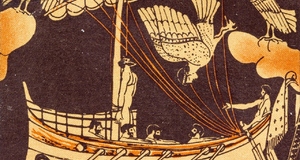From Discussions VOL. 5 NO. 2Four Lines to Immortality: Dido's Renaissance Through Josquin des PrezIt is useful to compare several translations in order to understand these lines fully. John Dryden's translation, given above, attempts to make English poetry of the Latin text. Dryden utilizes rhyme and iambic pentameter in his translation, which indicates that he was not simply aiming to translate the Latin text for his readers. He attempts to create English poetry as rich and meaningful as the original Latin. His ability to recast the original text demonstrates a sophisticated understanding of the poetry, and his version is to be applauded for its individual artistic endeavor. A second translation by Theodore Williams is a more literal treatment, though the language is still lofty. Sweet relics! Ever dear when Fate and Heaven This translation follows the word order as it appears in the Latin. Even though the English seems to be slightly out of place, this translation demonstrates that Virgil writes carefully to the meter, arranging the words so that they fit the dactylic hexameter8 scheme used in all Roman epic poetry. A more literal translation might have read: "and now in royal honor, my spirit goes to the world of death." Nigel Coulton's translation is particularly helpful in analyzing musical examples of the Dulces Exuviae. His translation is given as part of in the introduction to an edition of five Virgil motet settings from the fifteenth and sixteenth centuries. This translation utilizes plain language and follows the Latin progression directly: What he has left behind, sweet to me while fate and god allowed, Some of the most important features of these four lines are the in nature of Dido's words. Her tone is calm for a woman about to impale herself on her former lover's sword. Regardless of how she fell in love with Aeneas, Dido still dies a queen. She realizes that her destiny is not her own, but dominated by the whims of Fate as stated in the line that reads "uixi et quem dederat cursum Fortuna peregi." Oliver Strunk, a founding member of the American Musicological Society who is a prominent editor and writer for the society's journal, suggests that this section lends itself to a motet setting because the four lines are complete in themselves. Longer passages would have been far more cumbersome to set to music (Strunk, 488). The composer's poetic association of a tragic queen going solemnly to her death is a poignant text that is easy to manipulate with musical devices for heightened emotional impact. This sentiment is echoed by Leofranc Holford-Strevens, a prominent Renaissance scholar, as well: "Dido's lament seems to draw the composers in because her final words are not simply broken and lovestruck, but full of pride and a resignation to fate." (Holford-Strevens, 371). The University of Florida's motet database lists 26 motets from the late 14th through the 15th and 16th centuries (Thomas).9 Composers from Josquin des Prez to Orlando di Lasso are represented. In nearly all of the examples, the motets consist of the four lines beginning with "dulces exuviae." Only Orlando di Lasso in his 1570 setting extends the text to include more of the speech (Guentner, 66). The Josquin setting uses lines 651-654; Lasso continues on to line 660. The resulting composition is far longer than any of the other examples, but it is also one of the last incarnations of the Dulces exuviae motet. Josquin's setting of the Dulces exuviae is attributed to the composer in a manuscript from Brussels/Mechelen dated between 1516-1522 (Thomas). This makes Josquin's one of the earliest extant settings of the text. Josquin's work is highly attentive to the meaning of the Latin, and his overwhelming emphasis seems to be the repetition of important words and phrases and imitative gestures between parts. The motet does not give rhythmic emphasis to support the dactylic hexameter of the original poetry (Guentner, 64). However, the piece's structure is carefully organized by the Latin text; each major cadence10 occurs at the end of a poetic line, and each new point of imitation occurs at the beginning of a poetic line. Josquin's compositional style in this motet is centered around the clarity and meaning of the text rather than complicated melodic innovations. As the text is so short, Josquin divides many of the poetic lines into two units. The effect of this division is maintained clarity of text declamation in spite of the imitative horizontal motion. However, Josquin reserves prominent cadences (with authentic, or 5-1 bass motion) for the true ends of poetic lines. The strongest cadences occur at m.14 ("sinebat," the end of the first poetic line), m.22 ("curis," the end of line 2), m.33 (on "peregi," the end of line 3), and the final, drawn-out cadence in the last measure. The Dorian cadence at m.14 comes to a complete stop before moving to "accipite hanc" in m.15. The large cadence in m.22 (on "curis," also in Dorian) has a similar sensation of coming to a complete rest before continuing. While there are passing notes in the alto part, they come to rest in m.23 before the half note motion on "vixi et quem." One of the most striking cadences occurs at the end of the third line, in measure thirty three, on the words "magna mei." The soprano line has an ascending motion to the cadence which seems to highlight Dido's pride. The words "magna mei," which refer to her great name, and the ascending music seems to give the word a majestic emphasis. The bass also moves in a 2-1 motion instead of the stronger 5-1. However, this cadence occurs in the middle of a poetic line, and so the 2-1 motion is likely intentional. The beginning of the piece has a few smaller cadential gestures at the midpoints of lines, such as m. 10 (in the middle of "dum fata") and m.12 (in the middle of "deusque"), but these gestures are not as strong as the other cadences because one of the voices immediately moves to the next note or word of text.Continued on Next Page » Suggested Reading from Inquiries Journal
Inquiries Journal provides undergraduate and graduate students around the world a platform for the wide dissemination of academic work over a range of core disciplines. Representing the work of students from hundreds of institutions around the globe, Inquiries Journal's large database of academic articles is completely free. Learn more | Blog | Submit Latest in Literature |



















